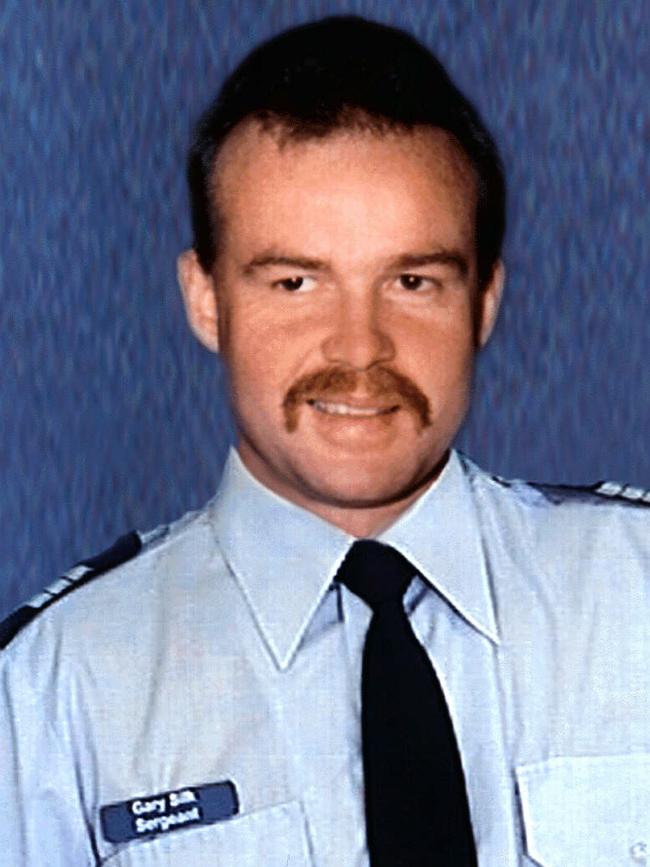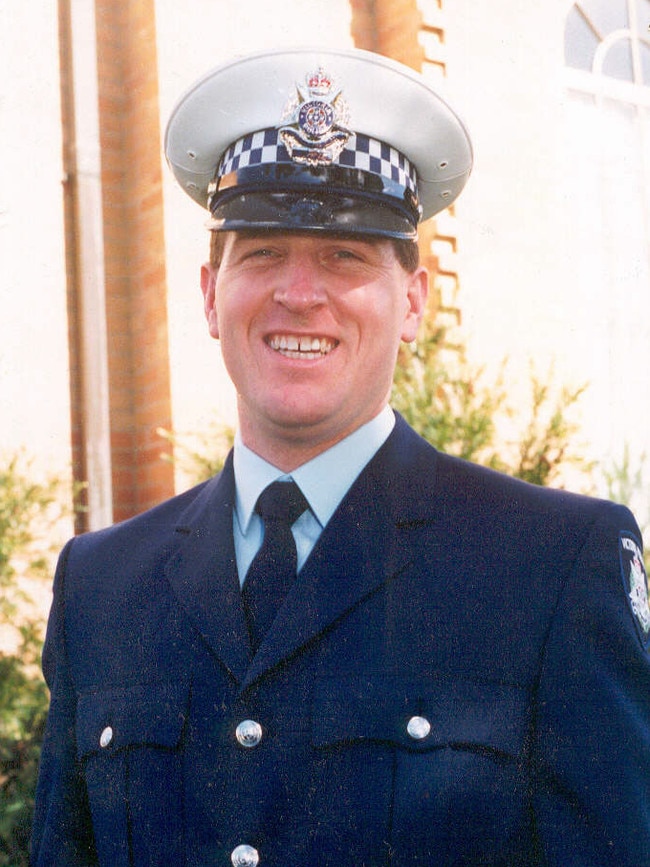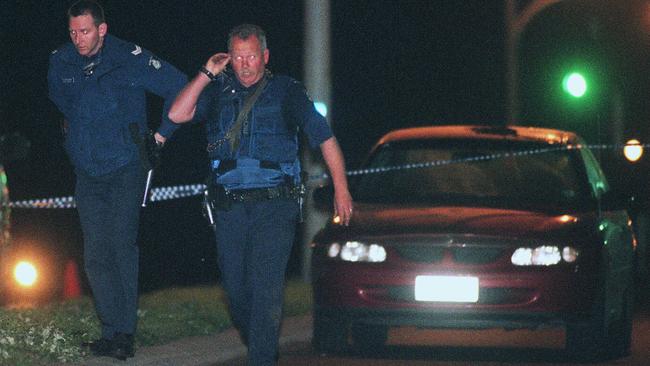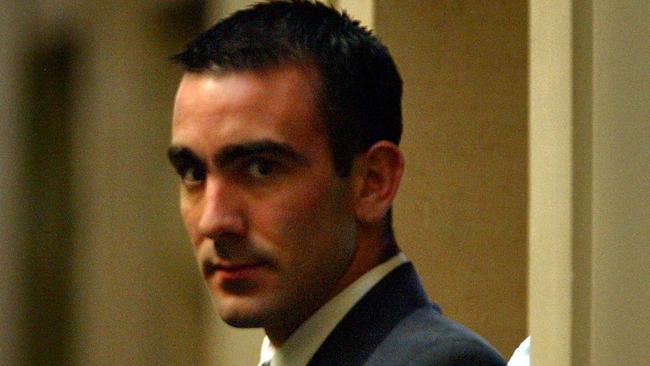Glenn Pullin’s statement about Rodney Miller’s final moments put to the test in Roberts’ retrial
Retired cop Glenn Pullin’s statement about Senior Constable Rodney Miller’s final moments will be put to the test in Jason Roberts’ retrial.

Police & Courts
Don't miss out on the headlines from Police & Courts. Followed categories will be added to My News.
The shots rang out in bursts.
They came with a bang, boom, bang, then silence, before a second volley of shots and then another.
From a vantage point in a side street off Cochranes Road, Moorabbin, police officers Darren Sherren and Frank Bendeich saw little more than silhouettes and muzzle flashes as their colleagues, S gt Gary Silk and Senior Constable Rodney Miller, came under fire.

In the minutes after midnight on August 16, it was too dark to see and too quiet not to hear.
It all happened so fast.
Sgt Silk and Sen Constable Miller, working undercover in their “scruffies’’, had pulled over a small hatchback, a Hyundai, and were talking to the driver.
It all seemed “fine’’, when he and his partner rolled by, Sherren would later testify.
The driver stood next to the Hyundai’s door speaking to Sgt Silk.
Police across Melbourne’s southeast had been watching “soft’’ targets, mainly restaurants, for a pair of armed robbers to strike.
It was codenamed Operation Hamada.
The officers - Bendeich, Sherren, Silk and Miller - were staking out the Silky Emperor Chinese Restaurant in Moorabbin, which was drawing to a close about 12.15am.
Officers Bendeich and Sherren had every reason to believe this ‘intercept’ of the Hyundai was routine.
The suspect had stopped in a dark stretch of Cochrane’s road, but the body language was relaxed.
Sherren and Bendeich did not see anyone else.
If they had, they would have stopped.


Instead, they parked in Cappella Crescent, a side street about 150m away from where they had a vantage point.
Within seconds shots rung out.
“Shots fired’’, Sherren yelled down the police radio.
As they crouched, the escaping Hyundai’s headlights moved toward them.
They did not note the number plate as it disappeared up the hill.
With guns drawn, they searched for their colleagues.
Officer Bendeich found Sgt Silk lying in a pool of his own blood and checked his pulse. There wasn’t one. His pen was by his side and his gun in its holster.
In the frantic aftermath a first responder finds Sen Constable Miller outside the Silky Emperor restaurant where he has staggered after being shot.
Officer Glenn Pullin was among the first to arrive by the wounded officer’s side after he hears a call, “help, help’’.

He comforts him and hears Sen Constable Miller say, “Silkies dead, Silkies dead.’’
Officer Pullin picks up Sen Constable Miller’s revolver and checks it, noting four rounds fired.
“Did you hit him?’’ he asks officer Miller.
“I don’t think so,’’ Sen Constable Miller replies.
Other police members surround officer Miller as he struggles to breathe and he speaks in a slow, staccato voice.
These words will become Miller’s “dying declaration’’.
And they will become the subject of contention.
The scene is chaotic, and recollections of Sen Constable Miller’s words will differ between officers.
One officer puts out a call over the police radio for “two offenders”, another recalls officer Miller say “one male offender on foot’’ while others will hear the injured officer state “two’’.
At this early stage, police are considering one gunman, since Bendeich and Sherren see only the driver.

A sketch is drawn up of one offender and released to the media.
A civilian witness, who drives by, will testify to seeing a single gunman.
But it will become evident two bullets were used to kill Sgt Silk, meaning two guns.
So were there two gunmen? Or was there one? The case is circumstantial.
It was enough to convict Jason Roberts of the Silk-Miller murders alongside serial killer and father figure, Bandali Debs, in 2002.
Roberts has always denied he was at the scene of the murders, and gave police an alibi.
In short, it was that he was planning his 18th birthday with his girlfriend, Bandali Debs’ daughter, Nicole.
Sen Constable Miller’s “dying declaration’’ was imperative to the two gunmen case.
The evidence gathering process, including the doctoring of a statement, now stands as the reason Roberts’ conviction has been quashed.

Significantly, most accounts of officer Miller’s “dying declaration’’ is put in statements made months and years after the shootings.
To counter this problem, Victoria Police’s Lorimer taskforce, which probed the Silk-Miller killings, had its key homicide detective, Sgt George Buchhorn, manipulate the evidence.
Sgt Buchhorn, dubbed by the Herald Sun as “The Fixer’’, begins tying the police accounts together.
Statements will be shredded and new statements will replace old ones.
Evidence will be left off the police brief, hidden from view, as if it does not exist.
And to hide the trail, police will commit perjury.
Officer Pullin is put in this unenviable position.
When he is approached by Sgt Buchhorn in mid-1999 to make another statement, about 10 months after the shootings, he complies.
His account becomes critical to the prosecution case of two offenders.
Officer Pullin’s second statement is then fraudulently backdated to the morning of the murders, as if it is a contemporaneous account - the events fresh in his mind.
Among conversation added to his statement was: “I also asked him ‘Were they in a car or on foot?’ and he replied ‘They were on foot’.
His original statement made just hours after he comforted and spoke to the dying Sen Constable Miller, was buried.
The Court of Appeal on Tuesday said this conduct corrupted the trial “to its roots”.
Prior to Tuesday’s landmark ruling, veteran homicide detective Ron Iddles raised the prospect of Mr Pullin falsifying his statement after a phone call with him in 2015.
IBAC, at a first attempt, could not substantiate the complaint.
Roberts case floundered in bureaucracy until the Herald Sun obtained Pullin’s original statement.
Anti-corruption body IBAC relaunched its operation - dubbed Gloucester - which would later make adverse findings against police officers.
And Mr Pakula, who had rejected Roberts initial petition for mercy despite obtaining advice to grant it, asked for it to be resubmitted.
Mr Pakula ultimately sent the case back to court a little more than year after rejecting his pleas.
It was the unearthing of the Mr Pullin “buried’’ statement that forced his hand.
It proved corruption and a substantial miscarriage of justice.
On Tuesday, the Herald Sun asked Mr Pullin, now retired and suffering PTSD from what he describes as the “nightmare’’ of the Silk-Miller shootings, if he stood by the words he testified Miller told him.
“Absolutely,’’ he said.
Roberts’ retrial will put those words to the test.
MORE NEWS:
